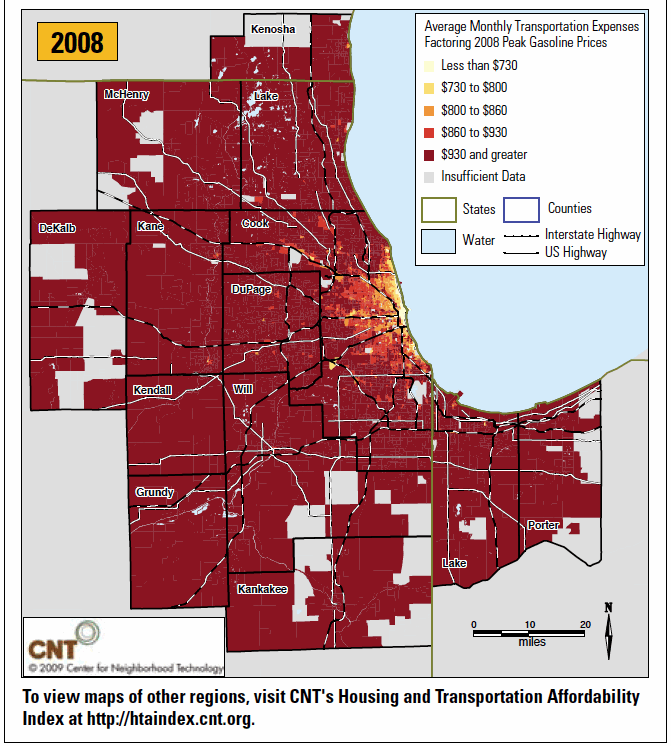NATURAL RESOURCES DEFENSE COUNCIL
While the nation continues to grapple with a troubling housing market and a rash of mortgage defaults, new research has emerged drawing a direct link between “location efficiency”—a measure of the transportation costs in a given area—and mortgage foreclosure rates. The study shows that factors such as neighborhood compactness, access to public transit, and rates of vehicle ownership are key to predicting mortgage performance and should be taken more seriously by mortgage underwriters, policymakers, and real estate developers. With transportation costs accounting for roughly 17 percent of the average American household’s income—and the ongoing foreclosure crisis still garnering much attention—the need for better land use planning and better lending practices has never been more clear. NRDC recommends changes both to planning-related policies and mortgage underwriting procedures that can reduce transportation costs and risk of foreclosure while offering significant environmental benefits.
Reducing Foreclosures and Environmental Impacts through Location-Efficient Neighborhood Design
What is Location Efficiency?
Location-efficient communities are neighborhoods where residents have access to an array of transportation options to meet their daily travel needs. The most important determinants of location efficiency are the compactness of residential development (number of housing units per acre of residential development) and the proximity of public transit (number of transit trips available per hour at transit stops within a walkable distance). Location-efficient areas are also characterized by a mix of nearby uses and services, shorter travel distances, a concentrated business district or downtown area, and more opportunities to walk, bike, or use transit to get around.
These alternative travel options allow people living in location-efficient neighborhoods to drive fewer miles and own fewer cars, saving them substantial amounts of money on automobile lease or purchase costs, maintenance, gas, insurance, and parking—effectively increasing household income in these areas.
Location Efficiency and Residential Mortgage Performance
Reduced automobile dependency creates an economic buffer for owners of location-efficient homes. The underlying principle is that the real cost of housing is a combination of mortgage and transportation costs. With more available alternatives to car ownership, residents of location-efficient homes have more flexibility when it comes to managing their transportation costs, making them less likely to default on a mortgage when compared to otherwise similar homeowners who spend a substantial portion of their household budget on automobile transportation.
For example, homeowners in location-efficient areas may be better protected against rising gas prices such as those observed in the summer and fall of 2008. Even before that spike in gas prices, transportation costs were the second largest expenditure for the typical American household, averaging $8,750 per year—or more than 17 percent of the average household’s pretax income. The Center for Neighborhood Technology has created a new index that takes into account the expected transportation costs associated with a home’s location, challenging current models that consider only mortgage debt service, property taxes, and home insurance. Analyzing the impact of gas prices on transportation costs shows that the expenses associated with living in car-dependent areas of metropolitan regions can be both volatile and much higher than conventional wisdom holds (see Figure 1). Unfortunately, standard lending practices account for only 9 percent of automobile-related transportation costs for a typical household.
Another aspect of location efficiency that may affect mortgage performance relates to home values. A study looking at 90,000 recent home sales in 15 different markets found a positive correlation between neighborhood walkability and home price, after controlling for both housing and other neighborhood characteristics. If location-efficient homes are more highly sought after, they will be less likely to fall as far in value as other homes in an economic downturn. If homeowners in these areas do default, selling the home may provide a viable alternative to foreclosure.
About the Natural Resources Defense Council
www.nrdc.org
“The Natural Resources Defense Council is an international nonprofit environmental organization with more than 1.3 million members and online activists. Since 1970, our lawyers, scientists, and other environmental specialists have worked to protect the world’s natural resources, public health, and the environment. NRDC has offices in New York City, Washington, D.C., Los Angeles, San Francisco, Montana, and Beijing.”
Tags: Chicago, Foreclosure, IL, Illinois, Location Efficiency, Natural Resources Defense Council, NRDC








 RSS Feed
RSS Feed